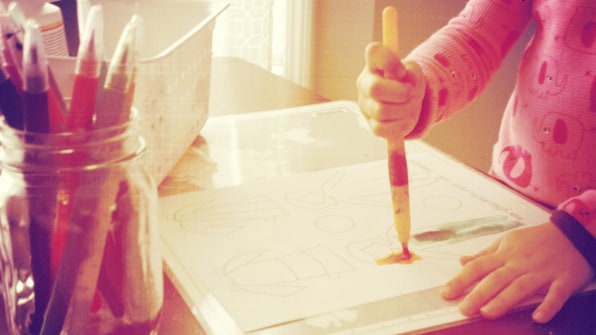I Serve So My My Kid Study Science and My Grandchild Study Art
Those who would consider themselves office of the creative course would probably hold that art is an of import part of master schoolhouse pedagogy. Since schoolhouse boards concerned well-nigh the lesser line don't necessarily agree, a team of social scientists at the Academy of Arkansas is trying to scientifically prove the benefits of exposure to art. What they institute, in a contempo study published in the journals Education Next andEducational Researcher, is that students who are exposed to cultural institutions, similar museums and performing arts centers, not only have higher levels of engagement with the arts but display greater tolerance, historical empathy, as well every bit improve educational memory and critical thinking skills.
"The changes were measurable and significant," says Jay P. Greene, professor of pedagogy reform and a researcher on the study. In item, a single museum bout was found to make "a definite impression on students." According to Greene, students on this tour remembered what they'd learned "even without an external reason for doing so–similar a grade or a test."

Ane GIGANTIC FIELD TRIP
When the 50,000-foursquare-foot Crystal Bridges Museum of American Art opened in Bentonville, Arkansas, two years ago, the museum offered xi,000 students free school tours. Each visiting group (chosen by lottery) viewed five paintings over the course of an 60 minutes. The tours were educatee-directed, which means curators did not lecture. Instead, they gave students minimal data about each painting and spent the majority of the time facilitating word.
Roughly three weeks afterward, students filled out a survey about their museum experience. In addition to recalling information almost the paintings they'd seen, they were asked general questions about their tolerance toward others and whether they felt able to empathize with people from unlike historical periods. Finally, they were asked to write a short essay near a new painting–The Box by Bo Bartlet–which was not on display at the museum. Students who had entered the lottery but had not received grouping tours, formed the report's control group. They were also given a survey asking nearly empathy and tolerance and directed to write a short essay about The Box. Independent judges then coded all the essays based on a well-regarded critical-thinking-skills cess plan.

ART MAKES YOU SMART–AND SENSITIVE
Greene'southward team was surprised past how much "academic" information the test group had learned and remembered about the museum paintings. Students were able to recall that ane painting dealt with price supports during the Not bad Low and that another depicted abolitionists boycotting sugar.
"These historical details were non standard in the curator's introduction," Greene explains. Which means that the discussion-based format compelled students to inquire both important and relevant questions about the paintings. Merely something well-nigh the museum experience too enabled students to remember this information nearly a month afterwards. That's remarkable, considering how quickly virtually kids forget noesis they've learned for tests.
Farther, when it came to analyzing the unfamiliar painting, Greene says at that place's "a big increment in how observant students were if they went to the art museum. They were much better at seeing details in the new painting than those who did not become." They were also better at relating the painting to their own experience, identifying subtext in the fine art, and allowing for multiple interpretations of the fine art. They were able to sympathise with the people and scenarios depicted in a way that the control grouping did not.
GET OUT OF Schoolhouse
"Before the study, a lot of people told us that the kids would just stare out the windows," says Greene. "Well, no, they don't. They're paying attention and absorbing data." Partly, this is linked to the non-lecture format of the experience. But Greene suspects the reason is also linked with removing students from their usual schoolhouse environment and putting them in a culturally engaged setting.

"Yous can give students a high-quality reproduction of a painting but it's non the same," he says. "It'south the difference between watching a televangelist and going to church. Information technology's why museums and churches invest in architecture. The act of going gets people into a mindset to receive the experience."
Information technology's not surprising that in Bentonville, a city with "a dearth of cultural experiences," co-ordinate to Greene, the biggest discrepancy betwixt the museum-goers and not-museum goers were students from disadvantaged backgrounds. Kids who were visiting the museum for the get-go time showed dramatic increases in disquisitional thinking, empathy, and tolerance.
Of course, the school boards however desire to know if the experience of visiting an fine art museum can assistance students better their critical thinking skills in more traditional subjects. "Nosotros don't know if art makes you better at critical thinking when solving a puzzle or a math problem," says Greene. "But we don't have to interpret math and reading into art to know they're good. Why should we have to translate art into reading and math? Fine art is doing something on its ain and that's what nosotros care almost."
Source: https://www.fastcompany.com/3023094/science-says-art-will-make-your-kids-better-thinkers-and-nicer-people
0 Response to "I Serve So My My Kid Study Science and My Grandchild Study Art"
Post a Comment